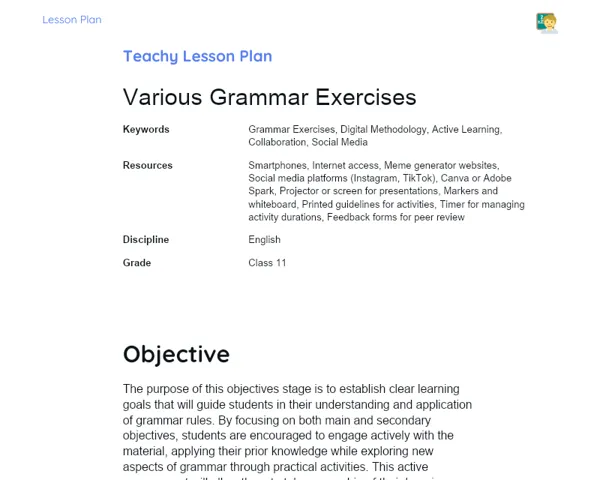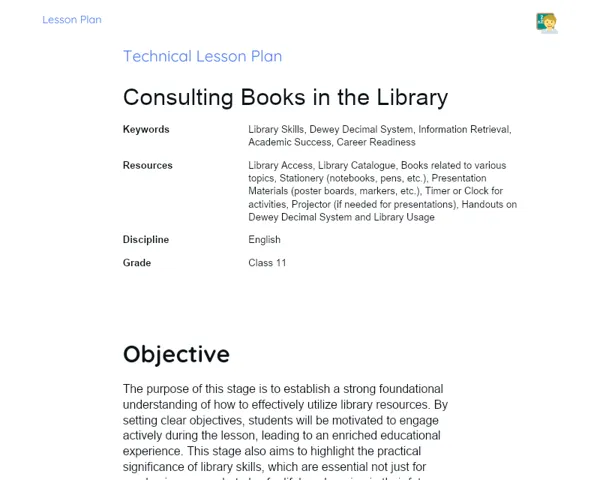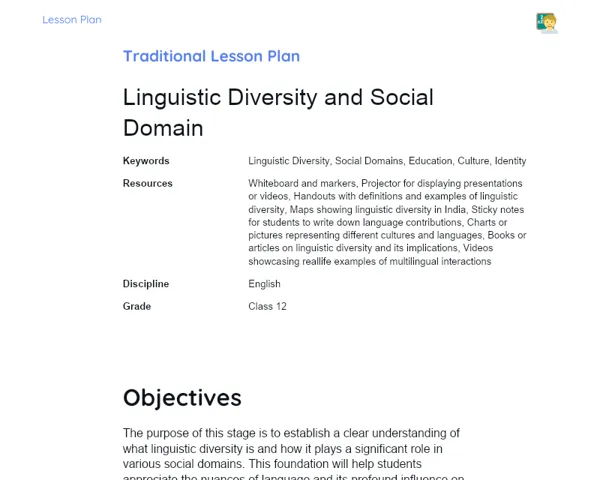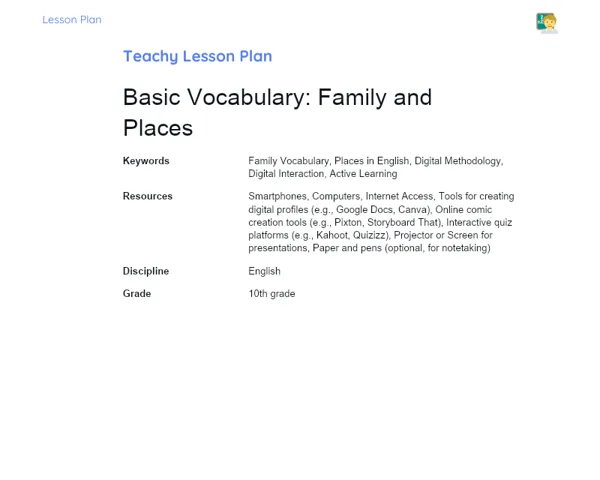Lesson Plan | Lesson Plan Iteratif Teachy | Verbs: Introduction to Modal Verbs
| Keywords | Modal Verbs, English Grammar, Digital Methodology, Active Learning, Engagement, Technology in Education, Social Media, Collaboration, Critical Thinking, Creativity, Digital Escape Room, Online Debate, 360° Feedback, Everyday Applications |
| Resources | Cell phones or tablets with internet connectivity, Content sharing platform (Google Classroom, WhatsApp, etc.), Video recording tools, Microblogging platform (Twitter or Google Classroom for a simulation), Gamification platform for Escape Room (Google Forms, Classcraft, etc.), Projector or screen for sharing content during the lesson, Writing materials (notebooks and pens) for notes and planning |
| Codes | - |
| Grade | 9th grade |
| Discipline | English |
Goal
Duration: 10 - 15 minutes
This stage aims to clearly articulate the primary and secondary goals of the lesson, ensuring that both the teacher and students are aligned on the learning objectives. This sets a strong groundwork for the practical activities to follow, linking previously explored theory to hands-on practice in a digital setting.
Goal Utama:
1. Understand the usage and implementation of modal verbs: can, could, may, must, and should.
2. Recognize the nuanced differences in meaning and contexts associated with each modal verb.
Goal Sekunder:
- Encourage the use of digital tools to discover examples of modal verbs in daily life.
- Foster collaboration among students through group activities and online discussions.
Introduction
Duration: 15 - 20 minutes
This stage is designed to engage students right from the start, utilizing their personal experiences and digital discoveries to spark learning. By incorporating mobile devices and social media platforms, students will recognize the practical relevance of modal verbs while reflecting on their application.
Warming Up
Modal verbs form a crucial component of English grammar, used for expressing possibilities, abilities, permissions, and obligations. To kick off, ask students to use their phones to find an intriguing or unique fact related to one of the modal verbs (can, could, may, must, should). This can involve usage examples, popular memes, or tweets that incorporate these modal verbs.
Initial Thoughts
1. What are some common uses of the modal verbs you discovered?
2. Can you share any fascinating example you found online?
3. Why do you believe modal verbs play a vital role in everyday communication?
4. Did anyone spot any memes or social media posts that use modal verbs in an amusing or interesting way?
Development
Duration: 70 - 80 minutes
This stage provides a hands-on, contextualized, and interactive experience, allowing students to consolidate their mastery of modal verbs through creative activities relevant to their digital lives. Additionally, it fosters teamwork, critical thought, and effective communication skills.
Activity Suggestions
Activity Recommendations
Activity 1 - Digital Influencer: The Art of Modal Verbs 📱
> Duration: 60 - 70 minutes
- Goal: Develop the ability to creatively and contextually explain grammatical concepts in an engaging manner while promoting teamwork and critical thinking.
- Deskripsi Activity: In this activity, students will craft content in the form of a video or social media post, explaining and illustrating the use of modal verbs. They will adopt the persona of digital influencers, leveraging humor, creativity, and cultural references to connect with their fictional audience.
- Instructions:
-
Form groups of up to 5 students.
-
Each group should choose one or more modal verbs (can, could, may, must, should) to focus on.
-
Using their mobile phones, record a brief video (maximum 2 minutes) or create a post featuring images and text that explain the use of the chosen modal verbs.
-
Integrate memes, cultural references, or real-life examples to demonstrate the modal verbs in an engaging and relatable manner.
-
Share the videos or images on an internal platform like Google Classroom or a private WhatsApp group.
-
Each group should view their peers' content and offer constructive feedback, pointing out strengths and suggestions for improvement.
Activity 2 - Digital Escape Room: Modal Verb Mission 🚀
> Duration: 60 - 70 minutes
- Goal: Reinforce the understanding and application of modal verbs in real-life contexts through a fun and stimulating activity that encourages teamwork and logical thought.
- Deskripsi Activity: Students will engage in a digital 'Escape Room' experience, where they must use modal verbs correctly to solve puzzles and progress to the next level. Each puzzle will be linked to everyday situations in which modal verbs apply.
- Instructions:
-
Divide the class into groups of up to 5 students.
-
Each group should access an online game platform that has been previously set up with puzzles (options like Google Forms, Classcraft, or other gamification tools can be used).
-
The puzzles will be presented through text, images, or videos, and students must select the correct modal verb for each scenario to unlock the subsequent puzzle.
-
Groups will have a time constraint to solve each puzzle (for example, 10 minutes per puzzle).
-
At the conclusion, the group that completes all puzzles in the least amount of time will be declared the winner.
Activity 3 - Twitter Classroom: Modal Verb Debate 🐦
> Duration: 60 - 70 minutes
- Goal: Practice the application of modal verbs in real argumentative contexts, promoting succinct writing and stimulating critical thinking and healthy discussion.
- Deskripsi Activity: In this activity, students will engage in an online debate using a microblogging platform (Twitter or a simulation on Google Classroom). They will post succinct tweets incorporating modal verbs to argue about a controversial topic presented by the teacher.
- Instructions:
-
Divide the class into groups of up to 5 students.
-
Each group will be assigned a controversial topic for debate, such as 'Should there be curfews for teenagers?' or 'Should everyone be allowed to work from home?'
-
During the debate, each group should post arguments using modal verbs (can, could, may, must, should) in tweets not exceeding 280 characters.
-
Groups should engage with tweets from others, fostering a dynamic and rich dialogue.
-
The teacher will moderate the debate, emphasizing the best uses of modal verbs and encouraging participation from all.
Feedback
Duration: 15 - 20 minutes
The aim of this stage is to solidify learning, reflect on strategies utilized, and foster self-assessment and peer evaluation. Through discussion and feedback, students can identify areas for growth and reinforce the knowledge gained collaboratively.
Group Discussion
To initiate the group discussion, suggest that each group share their experiences and takeaways. The teacher can start with this introduction: 'Now that everyone has had a chance to explore and apply modal verbs through various activities, let’s share our insights. Each group can briefly present what they learned, the challenges they faced, and the innovative solutions they crafted.'
Reflections
1. What was the most significant challenge you encountered while using modal verbs in the activities? 2. How did utilizing modal verbs in digital contexts (like social media and games) enhance your understanding of their functions? 3. Which example or approach had the most profound impact on the group's learning?
Feedback 360º
Instruct students to carry out a 360° feedback session within their groups. Explain that each member should receive constructive comments on their participation, highlighting both strengths and improvement areas. Encourage students to be respectful and specific in their feedback, for instance: 'I appreciated how you illustrated the verb 'can' with real-life examples, but perhaps we could have added more visuals to enhance clarity.'
Conclusion
Duration: 10 - 15 minutes
🎯 Purpose of the Conclusion 🎯: This phase aims to synthesize the lesson's key points, linking them to the students' experiences while highlighting their practical significance. Moreover, it consolidates learning in a light-hearted manner, aiding in concept retention. Through this engaging wrap-up, students leave with a clear and applicable understanding of modal verbs, prepared to utilize them in various everyday scenarios. 🚀📘
Summary
🎉 Summary of Modal Verbs 🎉: Think of modal verbs as the superpowers of the English language! They serve as magical tools that help convey possibilities 🎯, abilities 🏅, permissions 🚪, and obligations 📜. Today, students delved into these superpowers, exploring 'can' 🛠️, 'could' 🎭, 'may' 🎲, 'must' 🚦, and 'should' 📚 through innovative and digital methods. Fun was guaranteed with memes, videos, and even a Twitter-style debate! 🐦✨
World
🌐 Connection to Today’s World 🌐: The lesson today illustrated how modal verbs permeate our daily interactions, be it on social media, in online chats, or even in games. It emphasized that grammar is not merely a mundane concept from textbooks but a dynamic, vibrant tool that enables effective communication in the digital landscape 📱💬. Each digital activity underscored the relevance of these verbs in contemporary life, bridging theory and practice in a fun and engaging manner! 😎🚀
Applications
🔍 Applications in Life 🏠: Modal verbs are vital for clear and effective communication. Whether seeking permission, making suggestions, or conveying obligations, these verbs are omnipresent in our daily lives. Learning them through applied methods encourages their use in real settings, from drafting an email 👩💻 to chatting with foreign friends 🗣️, enhancing students' communicative abilities across various contexts. 🌟



